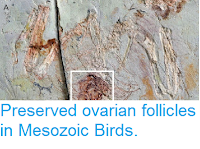Most Dinosaurs, including Mesozoic Birds, are known only from replacement fossils of bones, teeth, and other hard tissues, with a few rare sites such as the lithographic deposits of the Jehol or Crato biotas, or even rarer examples of Dinosaurs mummified before lithification, preserving additional details such as plumage and soft tissues. One type of deposit with potential for excellent preservation of plumage and soft tissues is amber, the preserved resin of ancient trees, which frequently preserves whole body fossils of Insects and other small animals. However Amber fragments, by their nature, tend to be very small, whereas Dinosaurs, for the most part, were extremely large, limiting the potential for the preservation of even Avian Dinosaurs in amber. To date, the known catalogue of Dinosaur specimens preserved in amber runs to a few feathers, a pair of Enantiornithine Bird wings and the tip of the tail of a small non-Avian Coelurosaurian Theropod.
In a paper published in the journal Gondwana Research on 6 June 2017, Lida Xing of the State Key Laboratory of Biogeology and Environmental Geology and School of the Earth Sciences and Resources at the China University of Geosciences, Jingmai O'Connor of the Key Laboratory of Vertebrate Evolution and Human Origins at the Institute of Vertebrate Paleontology and Paleoanthropology of the Chinese Academy of Sciences, Ryan McKellar of the Royal Saskatchewan Museum, the Biology Department at the University of Regina, and the Department of Ecology & Evolutionary Biology at the University of Kansas, Luis Chiappe of the Dinosaur Institute at the Natural History Museum of Los Angeles County, Kuowei Tseng of the Department of Exercise and Health Science at the University of Taipei, Gang Li of the Institute of High Energy Physics of the Chinese Academy of Science, and Ming Bai of the Key Laboratory of Zoological Systematics and Evolution of the Institute of Zoology of the Chinese Academy of Sciences, describe a preserved Hatchling Enantiornithine Bird from a piece of amber from the Angbamo site at Tanai Township in Myitkyina District of Kachin Province in northern Myanmar.
Middle Cretaceous ‘Burmese Amber’ has been extensively worked at several sites across northern Myanmar (though mostly in Kachin State) in the last 20 years. The amber is fairly clear, and often found in large chunks, providing an exceptional window into the Middle Cretaceous Insect fauna. This amber is thought to have started out as the resin of a Coniferous Tree, possibly a Cypress or an Araucaria, growing in a moist tropical forest. This amber has been dated to between 105 and 95 million years old, based upon pollen inclusions, and to about 98.8 million years by uranium/lead dating of ash inclusions in the amber.
The preserved Hatchling is not intact, having apparently only partly covered by resin initially, with part of the body therefore left exposed to the actions of the elements, and scavengers, and hence lost; the whole subsequently covered by additional layers of resin, and eventually preserved as amber. The remains are preserved in a block of amber approximately 86 mm x 30 mm x 57 mm and weighing 78.16 g. This block has been split into two sections during preservation; this split having unfortunately passed through part of the jaw, causing some loss of material. The remains comprise the head and most of the neck of the Bird, as well as a partial wing and the feet, and some additional plumage and soft tissue.
Overview of specimen in right lateral view. (A) Amber specimen; (B) x-ray μCT reconstruction; (C) illustration of observable plumage and skin sections. Two halves of amber piece have been positioned side by side (A) or separated by dashed line (C), and body regions scanned separately have been arranged in preservational position (B). For clarity in (C), only rachises of apical remiges indicated; and only rachises and rami of basal remiges, coverts, contours, and neoptile plumage indicated. Scale bars represent 10 mm. Xing et al. (2017).
The Bird appears to have two basic types of plumage, soft down feathers similar to those seen in modern Bird chicks, combined with longer fibrous feathers similar to those seen in many Dinosaurs, as well as some developed flight feathers on the wing. The skeleton is consistent with that of other preserved early-development Enantiornithine chicks, lending confidence to the diagnosis of this bird as an Enantiornithine. The developmental strategy in this Bird appears to have been different to that in modern Birds, in that it was apparently both arboreal (tree-dwelling) and precocial (able to move about immediately upon hatching). Modern Birds almost invariably follow one of two strategies; with tree-nesting species tending to need a period of care before leaving the nest (though many species do leave the nest before they can fly) and ground-nesting Birds producing precocial offspring that become active almost immediately.
See also...
See also...
Follow Sciency Thoughts on Facebook.







